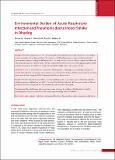Please use this identifier to cite or link to this item:
https://hdl.handle.net/20.500.14356/2002Full metadata record
| DC Field | Value | Language |
|---|---|---|
| dc.contributor.author | Dhimal, M | - |
| dc.contributor.author | Baral, K | - |
| dc.contributor.author | Shrestha, N | - |
| dc.contributor.author | Dhakal, P | - |
| dc.contributor.author | Maskey, M K | - |
| dc.date.accessioned | 2023-06-05T07:25:01Z | - |
| dc.date.available | 2023-06-05T07:25:01Z | - |
| dc.date.issued | 2010 | - |
| dc.identifier.citation | DhimalM., BaralK., ShresthaN., DhakalP., & MaskeyM. K. (2010). Environmental Burden of Acute Respiratory Infection and Pneumonia due to Indoor Smoke. Journal of Nepal Health Research Council. https://doi.org/10.33314/jnhrc.v0i0.213 | en_US |
| dc.identifier.issn | Print ISSN: 1727-5482; Online ISSN: 1999-6217 | - |
| dc.identifier.uri | http://103.69.126.140:8080/handle/20.500.14356/2002 | - |
| dc.description | Original Article | en_US |
| dc.description.abstract | Abstract Background: ARI and pneumonia is one of the major public health problems in Nepal which always ranks highest position among the top ten diseases. One of the risk factor of ARI and pneumonia is indoor smoke from kitchen where primary source of cooking is solid biomass fuel. This study was carried out in order to estimate the burden of ARI and pneumonia due to indoor smoke. ARI and pneumonia was chosen as it is one of the significant public health problem among under five children in Nepal and responsible for high number of premature deaths.  Methods: A cross-sectional study was conducted in Dhading district. Multistage cluster sampling technique was used for data collection considering ward as a cluster. The environmental burden of ARI and pneumonia due to indoor smoke was calculated using the WHO Environmental Burden of Disease Series. Results: About 87 percent of households were using solid biomass fuel as a primarysource of fuel. The under five children exposed to solid fuel use was 41313. The total 1284 Disability Adjusted Life Years were lost due to ARI and pneumonia and about 50 percent of it was attributed by Indoor smoke in household. Conclusions: The solid biomass fuel was primary source of energy for cooking in Dhading district which is attributing about 50 percent of burden of ARI and pneumonia among under  five children. Key words: acute respiratory infection,environmental burden of disease, indoor smoke, pneumonia, solid fuel us | en_US |
| dc.language.iso | en | en_US |
| dc.publisher | Nepal Health Research Council | en_US |
| dc.relation.ispartofseries | April, 2010;213 | - |
| dc.subject | Acute respiratory infection | en_US |
| dc.subject | Environmental burden of disease | en_US |
| dc.subject | Indoor smoke | en_US |
| dc.subject | Pneumonia | en_US |
| dc.subject | Solid fuel us | en_US |
| dc.title | Environmental Burden of Acute Respiratory Infection and Pneumonia due to Indoor Smoke | en_US |
| dc.type | Journal Article | en_US |
| local.journal.category | Original Article | - |
| Appears in Collections: | Vol 8 No 1 Issue 16 April 2010 | |
Files in This Item:
| File | Description | Size | Format | |
|---|---|---|---|---|
| 213-Article Text-211-1-10-20130822.pdf | Fulltext Download | 207.09 kB | Adobe PDF |  View/Open |
Items in DSpace are protected by copyright, with all rights reserved, unless otherwise indicated.
